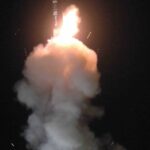
Beyond historical uncertainties, New Delhi’s emphasis on ‘Make in India’ introduces practical challenges in defence partnerships
By Vikas Gupta
Defence News of India, 6th Feb 24
Last week, President Joe Biden’s administration had to swing into action to persuade a senior United States (US) lawmaker, Senator Ben Cardin, to drop his objections to the sale of armed drones to India. Senator Cardin had placed a “hold” on the supply to India of 31 MQ-9 Predator and Sea Guardian drones until the US government carried out a “meaningful investigation” into an alleged conspiracy by “Indian agencies” to assassinate Gurpatwant Singh Pannun – a New York-based Khalistan activist whom New Delhi regards as a terrorist. Although the White House managed to persuade Cardin to revoke his “hold”, thus clearing the way for the drone sale to go through, the incident evoked memories of “American unreliability” that have long plagued relations between the two largest democracies.
Independent India’s strategic relationship with the US has long been argumentative, if not downright adversarial. In 1954, against the backdrop of the Cold War, the US and six allies co-opted Pakistan into joining the Southeast Asia Treaty Organization (Seato). While Seato’s stated aim was to prevent communism from gaining ground in the region, its appeal for Pakistan was the support it received in its struggles against India. Then, in 1959, Cold War geo-politics led the US into supporting Pakistan as a member of the Central Treaty Organisation (Cento). In 1971, President Richard Nixon and his Secretary of State Henry Kissinger supported Pakistan in the Bangladesh War, famously sending the 7th Fleet to flex its muscles at India in the Bay of Bengal. The next year, the US used Pakistani cover to send Nixon to China in a geo-strategic coup that altered the course of the Cold War. In 1999, India’s nuclear tests evoked outright hostility from Washington as well as sanctions on the supply of defence equipment.
Not until the turn of the century did US-India relations take a turn for the better with the signing in 2005 of a New Framework Agreement for the US-India Defence Relationship; the conclusion of the Defence Technology and Trade Initiative to bypass bureaucratic processes and procedures in both administrations, and the so-called 123 Agreement that opened the doors for civil nuclear cooperation between the two countries. In 2015, President Barack Obama and Prime Minister Narendra Modi signed a Joint Strategic Vision for the Asia-Pacific and Indian Ocean Region and, in 2016, the US designated India as a Major Defence Partner. In 2018, thebilateral security partnership reached a new level with the inaugural 2+2 Ministerial Dialogue – a cabinet-level meeting between American and Indian defence and foreign policy leaders. In 2018, the US granted India Strategic Trade Authorization, Tier One status, enabling India to access many of America’s highly-regulated technology items including the Predator and Sea Guardian drones that have run into controversy.
This raises an important question: Are US-India relations on firm ground? Or will they retain a disruptive moral component, with Washington continuing to cite its democratic values, love of freedom and the rule of law at inconvenient moments? Eventually, it is likely to remain subject to three parameters: The depth and strength of the military-to-military cooperation; the quantity of defence sales to India; and the defence-industrial cooperation between the two countries.
Military-to-military cooperation involves joint exercises and training, including the Special Forces Exercise Vajra Prahar, and the quadrilateral Exercise Malabar. Joint military exercises make for relationship building and the supply of US military equipment to India is facilitated when it is recommended by an American military service. But the US and India are still very far from mutual commitment in combat. While the US would welcome Indian involvement, New Delhi has little appetite for involvement in America’s wars. Throughout India’s recent confrontation with China in 2020-21, the Indian military was asking for information and intelligence, rather than weapons and equipment; and Washington was providing that readily. That is the area where US-India cooperation and jointmanship is working well.
In the realm of defence sales, the US weaponry bought by India is touching US $25 billion and will exceed that once the logjam on Capitol Hill is resolved. The US administration is tied to India’s commitment to account in full for its actions on the Pannun assassination conspiracy. And then the Hill is going to exercise its judgement on whether India has made a full accounting or not. There are other defence systems that the US could offer to India, such as carrier-borne fighter aircraft and additional P-8I multi-mission maritime aircraft, which are currently held up for lack of funds.
Thirdly, Washington and New Delhi are grappling with the question of “Make in India.” This is a mixed story, because the economics of transferring manufacturing to India is not immediately obvious. For example, India wants to equip its future Tejas fighters with the General Electric F-414 engines in India. The successful manufacture of this engine in India will be a test case of whether manufacturing can be transferred to India or not.
Indian policymakers must realise that, in buying small quantities of equipment, it becomes hard to start manufacturing those in India. In the US, production and assembly lines are set up and oriented to the US market and, to a secondary degree, to allied countries’ markets. And those are relatively large numbers.
Take the F-16, for example: A single assembly line in the US churned out some 3,000 F-16s over its lifetime. Then, when the European allies insisted on building their own F-16s, the US set up two more production lines – one in Italy and the other in Japan. Those two production lines churned out another 2,000 F-16s. The three assembly lines have built 5,000 F-16s between them.
If New Delhi says it wants to build the F-16s in India, it becomes very hard to find an economic-industrial rationale to justify the movement of an entire assembly line. Given that an Indian production line will have a relatively tiny production run of about 150 aircraft, the cost is naturally going to be prohibitive. For a relatively small production run, the jigs and tooling that would be required will essentially be the same as that for a full-scale, 1,000-aircraft production run. India cannot demand that, since it wants just 150 aircraft, it needs only a fraction of the tooling. The only way India could make such a production facility economically viable is by using India as a base for manufacturing for the global market. So India could buy about 150 aircraft with another 700 bought by other air forces.
There have been similar conversations around the Predator drone. India wanted to buy 31 drones, but insisted they be built in India. The Pentagon negotiating team said: “There are about 1,200 Predators flying world-wide; and every one of them was manufactured at a single facility in the US.”
Another sticking point is the Indian government’s invitation: “Come to India and manufacture here”. But that invites a question from the vendor: When we are manufacturing in the US and exporting to the world, why should we set up another manufacturing facility in India to export to the world?
Foreign OEMs also ask: What does the Indian environment give us that would make manufacturing here more financially attractive? The Indian argument typically goes: “We have the world’s cheapest and most skilled labour”. New Delhi fails to understand that, for most advanced military equipment, labour is no more than 5 per cent of the cost of the system!






